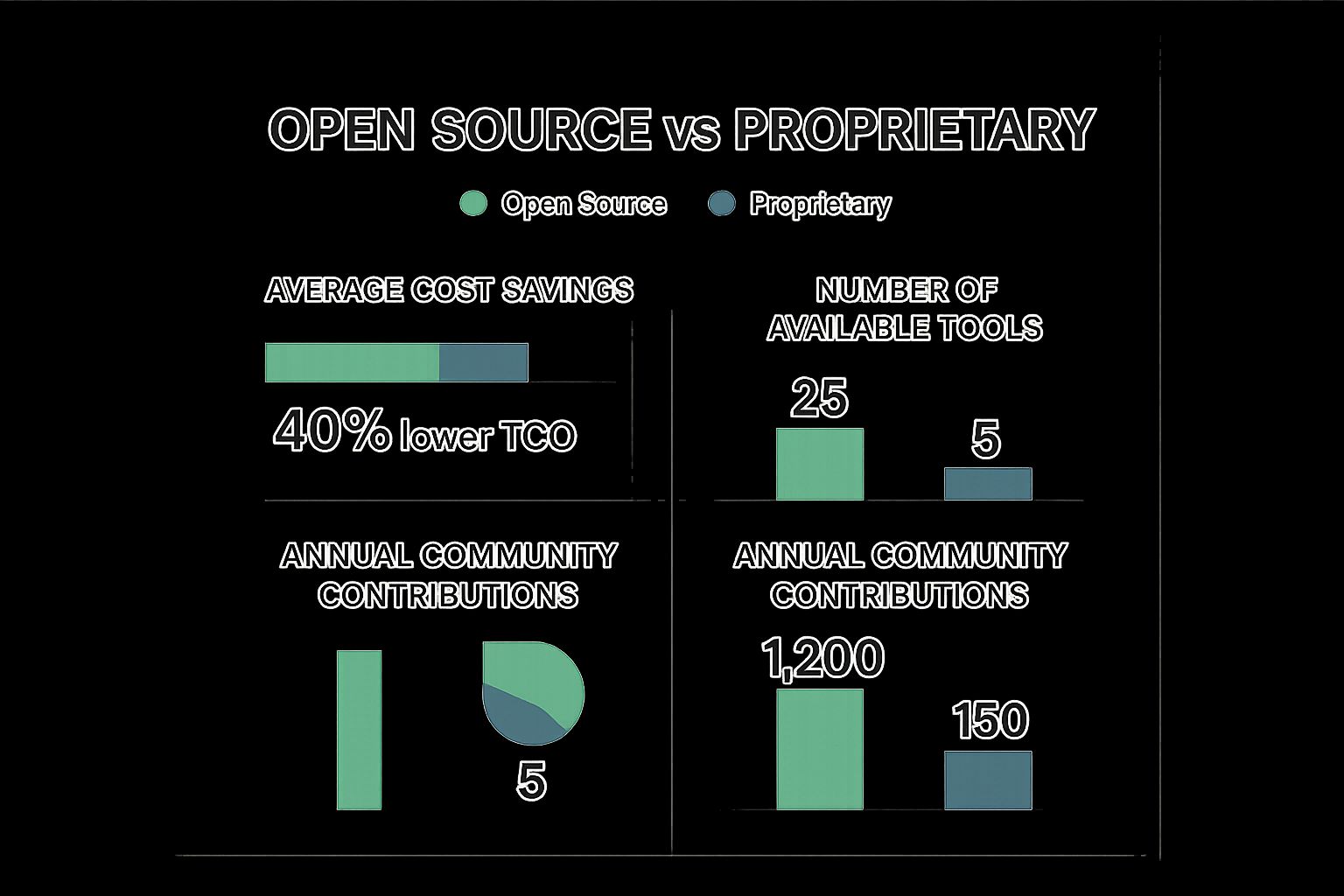Your Guide to Open Source Dispatching Software
At its heart, open source dispatching software gives you the source code for a dispatch system, letting you use, change, and share it however you see fit. This is a world away from proprietary software, which is basically a sealed, ready-to-go product. Think of an open source solution as a solid foundation that you can build on, giving your organization complete control to shape a system that fits your operation like a glove.
What Exactly Is Open Source Dispatching Software
Let’s try a simple analogy. Buying dispatching software is a bit like getting a car.
With a proprietary system, it’s like leasing a brand-new vehicle straight from the dealer. It looks great, it’s fully loaded, and it even comes with a maintenance plan. But that's where the control ends. You can't pop the hood and tune the engine, you can't swap out the dashboard, and you certainly can't install parts from another brand. You're locked into their world and their recurring fees.
Now, open source dispatching software is more like getting a high-performance car kit. You get the chassis, the engine, and all the key components, but you have total freedom to build it your way. Want to tune the engine for a little more horsepower? Go for it. Need to add a custom GPS or design a new interior? You can do it all without asking permission or paying extra for features you'll never use.
This really gets to the core of what makes open source so powerful: unmatched flexibility and control. Instead of forcing your team to adapt their workflow to the software, you adapt the software to your workflow.
The Financial and Operational Advantages
That level of control has a direct impact on your bottom line and how efficiently you operate. It’s why the open source software market is booming, projected to hit USD 90.66 billion by 2029. More and more organizations are tired of vendor lock-in and steep subscription costs. When you own the code, you say goodbye to those monthly license fees and per-user charges, which can easily save a small fleet hundreds, if not thousands, of dollars every single month. You can explore more insights about this market growth and see how it’s changing the game for businesses.
Practical Example: A local delivery service with 20 drivers pays $30 per driver per month for a proprietary system, totaling $7,200 a year. By switching to an open source model, they eliminate this license fee. Even after paying $1,500 for a year of cloud hosting, they save $5,700 in the first year alone. That's a direct cost saving that can be reinvested into the business.
Comparing Open Source and Proprietary Models
When you put these two models head-to-head, the differences really stand out. Let’s break it down in a simple table.
| Feature | Open Source Software | Proprietary Software |
|---|---|---|
| Cost | No license fees. Pay for hosting & optional support. | Recurring subscription or license fees. |
| Customization | Fully customizable. You own the code. | Limited to what the vendor allows. |
| Vendor Lock-In | None. You can switch hosting or support anytime. | High. Moving systems is difficult and costly. |
| Support | Community-driven, with paid expert support available. | Provided by the vendor, often at a premium. |
| Scalability | Unlimited users. Scale is limited only by hardware. | Often priced per user, so scaling is expensive. |
As you can see, the open source path offers a freedom and cost-effectiveness that proprietary models just can't match.
The infographic below really drives this home, visualizing the key data points that show just how much of an advantage open source solutions offer in cost, tool availability, and community support.

The data speaks for itself. Open source options consistently deliver a lower total cost of ownership (TCO) while being backed by a massive, active community of developers and users. This community-first approach leads to more tools, quicker problem-solving, and a treasure trove of shared knowledge. That all adds up to a more resilient and adaptable system for your organization.
Core Features Your Dispatch System Must Have
A dispatch system that actually works for you is a lot more than just a dot moving on a map. When you get the right features in place, it transforms from a simple tracking tool into a full-blown command center. It helps you drive efficiency, improve safety, and directly cut your operational costs. Without these core functions, any software—especially an open-source solution—is just not going to deliver.
Think of these features as the essential building blocks. They work hand-in-hand to create a clear operational picture, paving the way for faster decisions and smarter resource allocation.
Computer-Aided Dispatch (CAD)
At the heart of any serious operation is a Computer-Aided Dispatch (CAD) system. Honestly, you can think of CAD as the brain of your entire dispatch operation. It's the central hub where incidents are created, units get assigned, and every single action is logged for review later on. This isn't just about sending the nearest vehicle to a location; it's about managing incidents intelligently.
Practical Example: A security company gets an alarm notification. A solid CAD system can automatically log the event, suggest the closest patrol car based on their real-time location and status, and even push a complete history of incidents at that address to the responding officer's mobile device. This level of automation reduces human error, shaves precious seconds off response times, and ensures the officer arrives fully informed.
A huge part of what makes CAD so effective is its ability to handle workflow automation. It excels at turning clunky, manual processes into slick, automated sequences, which saves valuable time when it matters most.
Real-Time Unit Tracking and Mapping
Knowing where your people and vehicles are is non-negotiable, but modern dispatching demands more than a pin on a map. Real-time unit tracking needs to be paired with detailed, layered mapping to give you true situational awareness. This means seeing not just the current location of your vehicles but also their status—are they en route, on-site, or available for the next call?
This feature is a direct money-saver. Imagine a logistics company with a fleet of 20 delivery trucks. By using route optimization powered by real-time tracking, the system can pinpoint shorter, more efficient routes, navigate around traffic, and cut down on idle time.
Actionable Insight: Even a small 5% reduction in fuel consumption and mileage through smarter routing can save a mid-sized fleet thousands of dollars every year. For a truck that drives 50,000 miles a year, that's 2,500 fewer miles on the road. At $4.00/gallon and 6 MPG, that's a direct fuel saving of over $1,600 per truck, per year.
Multi-Channel Communication Tools
Clear and reliable communication is the absolute lifeline of any field operation. Any dispatch platform worth its salt has to integrate multi-channel communication, letting teams connect seamlessly through whatever method works best for the situation. This integration makes sure no message gets lost and everyone is on the same page.

Here are the must-have channels:
- Push-to-Talk (PTT) Voice: This brings traditional radio communication to cellular or Wi-Fi networks, giving you instant voice contact without the hassle and cost of old-school radio infrastructure.
- Secure Text Messaging: Perfect for sharing addresses, contact numbers, or sensitive info that you wouldn't want broadcast over an open voice channel.
- Group and Unit Chat: This allows teams to coordinate within specific groups (like "North Zone Units" or "Event Security Team") without cluttering up the main dispatch channel.
Actionable Insight: By integrating these tools into one platform, you can eliminate subscriptions for separate services. For a team of 30, dropping a standalone PTT app (at $7/user/month) and a messaging service ($5/user/month) saves $4,320 annually. This unified approach is the secret to a truly efficient and cost-effective operation. Learn more about the full range of features available in Resgrid.
Key Benefits of Choosing an Open Source Solution
Opting for an open-source solution for your dispatching needs brings some real-world benefits that go way beyond just the tech. We're talking about tangible impacts like lower costs, more operational agility, and a system you can actually shape to fit what you do. It’s a fundamental shift from renting a restrictive, one-size-fits-all tool to owning a flexible asset you control.

The first thing most people notice is the significant cost savings. With open-source dispatching software, you get to wipe out the recurring license fees that bleed budgets dry in proprietary models. This isn’t just a one-time thing; it’s about freeing your organization from never-ending subscription payments.
Drastic Cost Reduction and No Vendor Lock-In
Proprietary software loves to hook you with per-user or per-vehicle fees. That model seems manageable at first, but as your team grows, your costs spiral right along with it. Open-source architecture completely demolishes that barrier, letting you scale your operations without having to scale your software bill.
Practical Example: A local courier business with 20 drivers uses a proprietary system charging $45 per user per month, totaling $10,800 a year in license fees. By switching to an open-source solution they host themselves, their primary cost becomes server hosting (around $2,000/year). That's an immediate annual saving of $8,800 they can redirect into driver incentives or vehicle maintenance.
The Money-Saving Takeaway: With an open-source system, your main costs are hosting and optional support—both of which you control. This freedom from vendor lock-in means you're never backed into a corner, forced into expensive, mandatory upgrades just to keep things running.
This cost-saving potential is a huge reason why open-source adoption is booming. The 2025 State of Open Source Report found that 96% of organizations have either increased or maintained their use of open-source software, with a full 26% significantly ramping up their adoption. You can discover more insights from the full report to see just how big this trend is.
Total Flexibility and Customization
Financial wins are great, but the real power of open-source software is its endless adaptability. You have the source code. That means you can modify, extend, and tailor the platform to solve your unique operational challenges—a level of customization that's flat-out impossible with off-the-shelf products.
And this isn't just about changing colors or logos. It's about building features that give your team a critical edge when it matters most.
Practical Example: A volunteer search and rescue team operates in a remote, mountainous region. Using an open source platform, their tech-savvy volunteers build and integrate a custom module to fit their exact needs.
- Custom Alerts: They add a feature that flags when a K-9 unit is available, instantly notifying the incident commander.
- Skill-Based Dispatching: The system is tweaked to suggest responders based on specific certifications, like swift-water rescue or high-angle rope training.
- GIS Integration: They pull in local topographical map layers that aren't available in standard commercial mapping services.
This ability to mold the software to the mission transforms it from a generic tool into a purpose-built command system.
A Powerful Community for Support and Innovation
Finally, when you adopt a popular open-source dispatching software, you aren’t just getting a chunk of code; you’re joining a vibrant community of users, developers, and experts. This collective provides a deep well of shared knowledge and free support that often outstrips what a single vendor can offer.
If you hit a wall or need advice on a custom implementation, chances are someone in the community has already tackled a similar challenge and is willing to lend a hand. This network speeds up problem-solving and fuels continuous innovation, letting you improve your system without being stuck on a costly vendor's development timeline.
How Open Source Software Directly Saves You Money
Let's be honest, when you're looking at any new system, the bottom line is usually the deciding factor. While the technical freedom of open source is great, the financial argument is where things get really interesting. Choosing an open source dispatching software isn't just about dodging a price tag; it's about completely rethinking your operational costs for the long haul.
The key concept to get your head around is Total Cost of Ownership (TCO). This isn’t just the sticker price—it’s the sum of every direct and indirect cost you'll face over the software's entire life. Proprietary solutions can look good on day one, but their TCO tends to explode thanks to a never-ending stream of hidden and recurring fees.
Eliminating Direct Recurring Costs
The most immediate win is cutting out licensing and per-seat fees entirely. Proprietary software vendors build their businesses on subscriptions, charging you for every single person or vehicle you add.
Practical Example: A mid-sized field service company with 30 technicians uses a proprietary plan at $50 per user, per month. That’s $18,000 every single year—just for the right to use their software. With an open source alternative, that entire cost disappears. That's money that can now be allocated to new equipment, training, or profit.
This gives you incredible financial predictability. Your costs are tied to real things like hosting, not some arbitrary user count. As your team grows, your software bill doesn't have to.
Uncovering Significant Indirect Savings
Beyond the obvious license fees, the indirect savings are often where you find the real long-term value. These are the financial perks that pop up when you have total control and flexibility over your technology.
Here’s where you’ll find those savings:
- Reduced Hardware Expenses: Open source systems are often lighter and less resource-hungry. This means you can run them on cheaper, off-the-shelf hardware instead of being forced into buying expensive servers a vendor insists on.
- Targeted Development Costs: Instead of paying for a bloated, one-size-fits-all package full of features you’ll never touch, you invest only in the custom tools your operation actually needs. Paying a developer for 20 hours to build a specific integration is far cheaper than paying thousands a year for a premium tier you don't fully use.
- No Forced Upgrade Costs: Proprietary vendors love to push expensive, mandatory upgrades just to keep your support active. With open source, you decide if and when to upgrade, all on your own timeline and budget.
Actionable Insight: By focusing on what you actually need, you stop paying for a vendor's entire development roadmap and start investing directly into features that provide a clear return for your organization. For example, instead of paying for a "gold tier" package to get one feature you need, you can hire a freelance developer for a fraction of the cost to build that exact feature into your open source system.
A Five-Year Cost Analysis Example
Let’s put this into real numbers with a five-year cost breakdown for that same field service company with 30 technicians.
| Cost Component | Proprietary Software (Subscription Model) | Open Source Software (Self-Hosted) |
|---|---|---|
| Year 1 Initial Setup | $2,000 (Implementation Fee) | $5,000 (Developer Setup & Customization) |
| Year 1 Recurring Costs | $18,000 (License Fees) | $2,400 (Server Hosting) |
| Year 1 Total | $20,000 | $7,400 |
| Total Cost Over 5 Years | $92,000 | $17,000 (Including minor updates) |
As you can see, while the initial setup for open source can be a bit higher, the long-term savings are massive. Over five years, the company saves $75,000—money that can go right back into growth, equipment, or your people. While this example uses a self-hosted model, many organizations also opt for managed plans. You can see how different structures impact your budget by reviewing Resgrid’s pricing models. This breakdown gives you a clear framework for figuring out the serious financial benefits for your own organization.
Real-World Examples of Dispatching Software in Action
Theories and feature lists are great, but the real test is seeing how a tool solves actual, on-the-ground problems. This is where open source dispatching software really shines. We're not just talking about abstract ideas; organizations out there right now are using this tech to slash costs, tighten up operations, and deliver a better service.
Let's walk through a few scenarios. Each one starts with a specific operational headache and ends with a measurable win, all thanks to the flexibility of open source.

Optimizing a Regional Courier Service
Practical Example: A local courier company was struggling with rising fuel costs and inefficient delivery routes. Drivers were stuck in traffic, and dispatchers were overwhelmed with customer calls asking for updates.
By implementing an open source dispatching system connected to real-time traffic data, they automated their route planning. The software now crunches the most efficient routes every morning, a task that used to take a manager hours.
- The Result: They cut fuel consumption by 15% within six months.
- Actionable Insight: They also built a simple customer portal with live tracking links. This feature nearly eliminated "where's my package?" calls, freeing up dispatch staff by an estimated 5 hours per week and dramatically improving customer satisfaction. That's over 250 hours of saved labor per year.
Coordinating a Rural Volunteer Fire Department
Practical Example: A sprawling rural county's volunteer fire department faced chaotic communication. Responders were scattered, and coordinating a unified response using their old radio system was slow and ineffective, wasting precious minutes during emergencies.
They adopted an open source platform they could mold to fit their needs. Now, when a 911 call comes in, the system instantly alerts all available volunteers via a mobile app, showing them the incident location, required gear, and the real-time position of other responding units.
They configured the system to create virtual "mutual aid" groups on the fly, ensuring the closest, best-equipped teams were always dispatched first, regardless of their home station. This simple customization led to a massive drop in response times and a more effective, coordinated operation.
Managing a Public Works Snowplow Fleet
Practical Example: A city's public works department was under pressure to clear roads faster after snowstorms. Their manual process of assigning streets from a list meant critical routes to hospitals and major arteries weren't prioritized, leading to public complaints and safety risks.
Using an open source dispatching software with GIS mapping, they layered custom data onto the city map to build a smarter, tiered plowing strategy.
- Tier 1: Main arteries and emergency routes.
- Tier 2: School zones and public transit routes.
- Tier 3: Residential streets.
Dispatchers could now assign plows to specific zones and track progress live, ensuring critical areas were cleared first. This data-driven approach not only improved public safety but also provided clear documentation to justify their operational decisions and resource allocation.
Dispatching Software Applications by Industry
As you can see, the core idea of dispatching software—getting the right resources to the right place at the right time—applies across a huge range of fields. The beauty of an open source solution is its ability to adapt to the unique language and challenges of each one.
Here’s a quick look at how different industries put this technology to work.
| Industry | Primary Challenge | How Open Source Software Helps |
|---|---|---|
| Emergency Services | Rapid, coordinated response to life-threatening situations with limited resources. | Real-time personnel and unit tracking, automated alerting, and incident mapping ensure the closest, most appropriate units are dispatched instantly. |
| Logistics & Delivery | Fuel costs, inefficient routing, and lack of real-time visibility for customers. | Dynamic route optimization based on traffic, GPS tracking for fleet management, and customer-facing portals for live delivery updates. |
| Field Service | Scheduling a mobile workforce, tracking job progress, and managing inventory. | Centralized job scheduling, mobile apps for technicians to update status and notes, and inventory tracking tied to specific jobs or vehicles. |
| Public Works | Managing diverse assets (plows, sanitation trucks) and prioritizing tasks across a wide area. | GIS integration allows for custom map overlays and zone-based assignments, providing real-time progress tracking for tasks like snow removal. |
| Towing & Roadside | High call volume, locating stranded motorists, and assigning the nearest available truck. | GPS-based dispatching identifies the closest driver, while mobile communication tools streamline the exchange of information and payment. |
Ultimately, whether you're managing firefighters or delivery drivers, the goal is the same: eliminate chaos and replace it with clarity. An open source platform gives you the toolkit to build a system that does exactly that, tailored perfectly to your operational needs.
Getting Started with Resgrid as Your Open Source Option
Alright, let's move from the "what if" to the "how-to." This is where the real value of open source dispatching software starts to click. Resgrid isn't just a concept; it's a powerful, ready-to-go solution that packs all the features we've been talking about, giving you a clear path to get up and running.
The first question you need to ask is a simple one: Do you want to get started immediately without fussing with servers, or do you need to roll up your sleeves and get total control over the code? Resgrid is built for both, so any organization can start improving its dispatch operations right away.
The Easiest Path: The SaaS Version
For a lot of teams, the fastest and most practical way forward is with Resgrid’s hosted Software-as-a-Service (SaaS) version. Think of it as the "batteries-included" model. You get the full power of the platform without having to worry about managing servers, databases, or software updates. We handle all the technical heavy lifting.
This approach is perfect for teams that don't have a dedicated IT department or for those who just want to kick the tires and see what the system can do before committing to hosting it themselves.
Actionable Insight: A small security company can sign up for a free or low-cost SaaS plan and have its entire team of 15 officers connected and tracked in a single afternoon. This immediately saves money by eliminating the need for separate messaging apps (~$5/user/month) and manual radio check-ins, saving over $900 a year on app subscriptions alone—all without any upfront hardware or development costs.
The image below shows the clean, organized dashboard that greets you. It’s designed to give you an at-a-glance view of your entire operation.
This centralized view is all about clarity. Dispatchers can see active calls, personnel status, and map data in one place, which is absolutely critical for making smart decisions when time is of the essence.
Full Control: The Self-Hosted Open Source Code
For organizations that need absolute control—the ability to customize everything and keep all their data on their own servers—the self-hosted open source route is the way to go. This path gives you the keys to the kingdom. You can modify the source code, hook it into your other internal systems, and run it on your own infrastructure.
Practical Example: A public works department could integrate the software directly with its existing GIS data for city-owned assets (like fire hydrants or storm drains) and its fleet maintenance software. This creates a single, unified system for dispatch and asset management that would be impossible—or prohibitively expensive—to build with a closed, off-the-shelf product.
Jumping in on this path involves a few key steps:
- Access the Code: The complete source code is available on GitHub. This is your starting point for downloading the software and getting familiar with its architecture.
- Consult the Documentation: We’ve put together detailed documentation that provides instructions for setup, configuration, and development. It's your guide to getting the system running on your servers.
- Connect with the Community: Don't go it alone. Engage with other developers and users for support, share ideas, and even contribute back to the project.
This approach lets you build a dispatch system that is perfectly tailored to your unique operational needs. To start exploring, check out the Resgrid open source repository and resources. It’s your gateway to building a truly custom solution that saves money and drives efficiency for years to come.
Got Questions? We've Got Answers
Jumping into the world of open-source dispatching software can feel a little different, and it's smart to ask a few questions before you commit. You’re probably wondering about things like support, security, and whether it can grow with your team. Let's tackle some of the most common ones we hear.
What Happens When I Need Technical Support?
When you run into a snag with proprietary software, you call a vendor. In the open-source world, things are a lot more flexible, and you're definitely not on your own. Most projects, including ours at Resgrid, have lively communities full of experienced users and developers who are happy to offer advice.
Actionable Insight: Instead of paying a mandatory $5,000 annual support contract for a proprietary system, you can save that money. If you encounter a problem, you can hire a freelance developer from the community for a few hundred dollars to fix the specific issue. This "pay-as-you-go" support model saves you thousands over the long term by avoiding fixed costs for support you may rarely use.
Is Open-Source Software Secure?
This is a big one, and the answer might surprise you: open-source software is often incredibly secure, thanks to its transparency. Because the source code is out in the open, thousands of developers all over the world can look it over for any weaknesses. That's a level of scrutiny most closed-source, proprietary code never gets.
Think of it as the "many eyes" approach. With so many people examining the code, potential security flaws get spotted and fixed, and fast.
Our Two Cents: The best way to keep things secure is to always run the latest stable version of the software and follow the community's best practices for locking down your server. Being proactive is way more effective than just waiting on a single company to push out a security patch.
Can Open-Source Scale with My Organization?
Absolutely. In fact, this is where open-source dispatching software really shines. Since there are no per-user license fees, you can bring on hundreds of new users or vehicles without your software bill getting any bigger.
Practical Example: A delivery startup begins with 5 drivers. A proprietary system might be affordable. But when they scale to 50 drivers within a year, their license fees would increase tenfold. With an open source system, their software cost remains zero. They only need to scale up their server resources (a predictable and much smaller cost), allowing them to grow without being penalized by their software vendor.
Ready to take the reins of your dispatching operations with a solution that's flexible, powerful, and won't break the bank? Resgrid gives you an open-source platform you can truly make your own. Start for free today!

